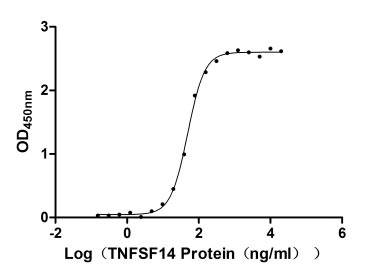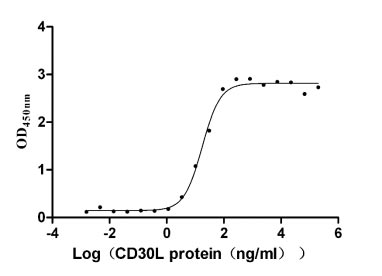Recombinant Rat Potassium channel subfamily K member 9 (Kcnk9), partial
-
中文名称:大鼠Kcnk9重组蛋白
-
货号:CSB-YP861699RA1
-
规格:
-
来源:Yeast
-
其他:
-
中文名称:大鼠Kcnk9重组蛋白
-
货号:CSB-EP861699RA1
-
规格:
-
来源:E.coli
-
其他:
-
中文名称:大鼠Kcnk9重组蛋白
-
货号:CSB-EP861699RA1-B
-
规格:
-
来源:E.coli
-
共轭:Avi-tag Biotinylated
E. coli biotin ligase (BirA) is highly specific in covalently attaching biotin to the 15 amino acid AviTag peptide. This recombinant protein was biotinylated in vivo by AviTag-BirA technology, which method is BriA catalyzes amide linkage between the biotin and the specific lysine of the AviTag.
-
其他:
-
中文名称:大鼠Kcnk9重组蛋白
-
货号:CSB-BP861699RA1
-
规格:
-
来源:Baculovirus
-
其他:
-
中文名称:大鼠Kcnk9重组蛋白
-
货号:CSB-MP861699RA1
-
规格:
-
来源:Mammalian cell
-
其他:
产品详情
-
纯度:>85% (SDS-PAGE)
-
基因名:Kcnk9
-
Uniprot No.:
-
别名:Kcnk9; Task3; Potassium channel subfamily K member 9; Acid-sensitive potassium channel protein TASK-3; TWIK-related acid-sensitive K(+ channel 3; Two pore potassium channel KT3.2; Two pore K(+ channel KT3.2
-
种属:Rattus norvegicus (Rat)
-
蛋白长度:Partial
-
蛋白标签:Tag type will be determined during the manufacturing process.
The tag type will be determined during production process. If you have specified tag type, please tell us and we will develop the specified tag preferentially. -
产品提供形式:Lyophilized powder
Note: We will preferentially ship the format that we have in stock, however, if you have any special requirement for the format, please remark your requirement when placing the order, we will prepare according to your demand. -
复溶:We recommend that this vial be briefly centrifuged prior to opening to bring the contents to the bottom. Please reconstitute protein in deionized sterile water to a concentration of 0.1-1.0 mg/mL.We recommend to add 5-50% of glycerol (final concentration) and aliquot for long-term storage at -20℃/-80℃. Our default final concentration of glycerol is 50%. Customers could use it as reference.
-
储存条件:Store at -20°C/-80°C upon receipt, aliquoting is necessary for mutiple use. Avoid repeated freeze-thaw cycles.
-
保质期:The shelf life is related to many factors, storage state, buffer ingredients, storage temperature and the stability of the protein itself.
Generally, the shelf life of liquid form is 6 months at -20°C/-80°C. The shelf life of lyophilized form is 12 months at -20°C/-80°C. -
货期:Delivery time may differ from different purchasing way or location, please kindly consult your local distributors for specific delivery time.Note: All of our proteins are default shipped with normal blue ice packs, if you request to ship with dry ice, please communicate with us in advance and extra fees will be charged.
-
注意事项:Repeated freezing and thawing is not recommended. Store working aliquots at 4°C for up to one week.
-
Datasheet :Please contact us to get it.
相关产品
靶点详情
-
功能:pH-dependent, voltage-insensitive, background potassium channel protein.
-
基因功能参考文献:
- results demonstrate that neurotensin (NT) transiently increased the neuronal excitability of dentate gyrus granule cells (GCs) by inhibiting TASK-3 channels; NT-mediated increases in neuronal excitability facilitate long-term potentiation at the perforant path-GC synapses PMID: 25405940
- Hydroxy-alpha sanshool evokes colonic motility via blockage of the neural KCNK9 channel in the colonic myenteric plexus. PMID: 25634809
- the entire rat brain was immunocytochemically analyzed for expression of TASK-3 protein. PMID: 24077856
- Expression of the TASK-3 protein in motor systems of the rat central nervous system was examined. PMID: 22011781
- Results suggest that expression of TASK-2 and TASK-3 (but not TASK-1) undergoes age-related changes in dorsal root ganglion (DRG) neurons; TASK-2 and TASK-3 are likely to contribute to resting membrane potential in DRG neurons in neonates and adults. PMID: 22017174
- TASK-3 immunoreactivity was observed in neurons of the rat hippocampus PMID: 21710317
- Immunofluorescence double-labeling experiments with appropriate marker enzymes confirmed the expression of TASK-3 in cholinergic, serotoninergic, and noradrenergic neurons. PMID: 21082237
- mRNA expression of TASK3 was significantly higher in SHR than in WKY carotid bodies before hypertension developed. PMID: 20019330
- TASK-3 dominates the resting potassium conductance of zona glomerulosa cells PMID: 11875121
- Task3 distribution in the carotid body is limited to type I cells and vascular smooth muscle cells. PMID: 12231257
- TASK-3 mRNA is present in ventrolateral medulla neurons that regulate respiration or circulation (C1 adrenergic neurons). TASK channels are expressed by respiratory cells with putative rhythmogenic function and by premotor and motor neurons. PMID: 14519375
- Localization of the Task-3 protein was studied. PMID: 14574589
- role for TASK-3 in modulating cerebral synaptic transmission and responses to central nervous system active drugs PMID: 15178438
- first mutation found in a genetic model of absence epilepsy (GAERS), identified at the genomic level in the KCNK9 gene; a trinucleotide insertion, which expands a polyalanine region in the intracellular C-terminal tail of the TASK3 channel PMID: 15781965
- TASK3 and HCN2 channels stabilize the membrane potential by a mutual functional interactions. PMID: 16760342
- TASK-3 transcription is regulated by membrane potential via the calcineurin pathway PMID: 16864570
- Characterization of the 5' and 3' untranslated regions of TASK-3 gene involved in gene regulation. PMID: 16925981
- TASK-3-like background K(+) currents contribute to establishing membrane potential in striatal cholinergic interneurons PMID: 17167057
- Thus, neuronal excitability of PnC giant neurones in vivo is most likely increased by serotonergic projections via the K(2)P channel TASK-3. PMID: 18691333
显示更多
收起更多
-
亚细胞定位:Cell membrane; Multi-pass membrane protein.
-
蛋白家族:Two pore domain potassium channel (TC 1.A.1.8) family
-
组织特异性:Highly expressed in the CNS and at lower levels in the colon, kidney, liver, lung, spleen, stomach and skeletal muscle. The highest expression was found in the olfactory nuclei, piriform cortex, cerebellum, antedorsal thalmic nucleus, pontine nucleus, dor
-
数据库链接:
KEGG: rno:84429
STRING: 10116.ENSRNOP00000012408
UniGene: Rn.48796
Most popular with customers
-
Recombinant Human Tumor necrosis factor ligand superfamily member 14 (TNFSF14), partial (Active)
Express system: Mammalian cell
Species: Homo sapiens (Human)
-
Recombinant Human Tumor necrosis factor receptor superfamily member 8 (TNFRSF8), partial (Active)
Express system: Mammalian cell
Species: Homo sapiens (Human)
-
Recombinant Human R-spondin-1 (RSPO1), partial (Active)
Express system: Mammalian cell
Species: Homo sapiens (Human)
-
Recombinant Human Claudin-4 (CLDN4)-VLPs (Active)
Express system: Mammalian cell
Species: Homo sapiens (Human)
-
Recombinant Human Complement component C1q receptor (CD93), partial (Active)
Express system: Mammalian cell
Species: Homo sapiens (Human)
-
Recombinant Human Lymphocyte antigen 6 complex locus protein G6d (LY6G6D) (Active)
Express system: Yeast
Species: Homo sapiens (Human)
-
Recombinant Macaca fascicularis Membrane spanning 4-domains A1 (MS4A1)-VLPs (Active)
Express system: Mammalian cell
Species: Macaca fascicularis (Crab-eating macaque) (Cynomolgus monkey)
-
Recombinant Human Cell adhesion molecule 1 (CADM1), partial (Active)
Express system: Mammalian cell
Species: Homo sapiens (Human)




















